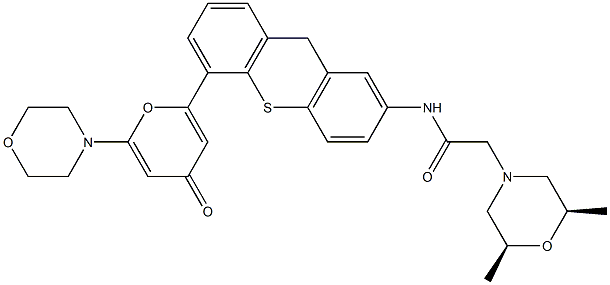KU-60019 is an improved analogue of KU-55933, with IC50 of 6.3 nM for ATM in cell-free assays, 270- and 1600-fold more selective for ATM than DNA-PK and ATR,and is a highly effective radiosensitizer.
Improved analog of KU-55933, and is more effective at blocking ATM-mediated DDR events.
Compared to KU-55933, KU-60019 is an improved more water-soluble inhibitor of the ATM kinase, while displaying similar target selectivity. KU-60019 has little activity against DNA-PKcs and ATR with IC50 values of 1.7 μM and >10 μM, respectively, as well as 229 other protein kinases such as PI3K, mTOR and mTOR/FKBP12. KU-60019 displays 3- to 10-fold more potency than KU-55933 at blocking radiation-induced phosphorylation of key ATM protein targets such as p53, γ-H2AX, and CHK2, in human glioma U87 and U1242 cells, as 1 μM of KU-60019 significantly induces >70% decrease of p53 (S15) phosphorylation to which extent ~10 μM of KU-55933 is required to achieve. KU-60019 effectively radiosensitizes human glioma cells with dose-enhancement ratio of 1.7 and 4.4 at 1 μM and 10 μM, respectively, and also radiosensitizes the normal fibroblasts but not the A-T fibroblasts. KU-60019 treatment (3 μM) blocks basal and insulin-induced AKT S473 phosphorylation by 70% and ~50%, respectively, and completely reduces radiation-induced AKT phosphorylation below the level of control. The effect of KU-60019 on AKT S473 phosphorylation can be seen in glioma cell lines and normal fibroblasts but not in A-T (h-TERT) cells, and can be significantly blocked by phosphatase inhibitor okadaic acid, suggesting a critical role of ATM kinase in regulating AKT phosphorylation via unknown phosphatase. Consistent with the inhibition of prosurvival AKT signaling, KU-60019 at 3 μM significantly inhibits migration and invasion of human glioma U87 cells by >70% and ~60%, respectively, as well as U1242 cells by >50% and ~60% respectively.
In orthotopic glioma U1242/luc-GFP xenograft models, the combination of KU-60019 and radiation significantly increases survival of mice than KU-60019 alone, radiation alone, or no treatment. In addition, p53-mutant gliomas is much more sensitive to KU-60019 radiosensitization than wild-type glioma.
KU-60019 has been used to block ataxia telangiectasia mutated (ATM), to study its association of with the regulation of H2AX (H2A histone family, member X) and apoptosis inducing factor (AIF)-mediated cell death.
ku-60019 is a selective inhibitor of the ataxia telangiectasia (a-t) mutated (atm) protein with an ic50 value of 6.3 nm. in literature report, ku-60019 radiosensitizes h-tert-immortalized normal fibroblasts but not a-t fibroblasts, suggesting it is a specific atm kinase radiosensitizer [1].ku-60019 can reduce radiation-induced s473 akt phosphorylation in human glioma cell lines that are p53 wild type (u87) and p53 mutant (u1242). however, the suppression of akt does not enhance radiosensitization of ku-60019 [1].ku-60019 has been reported to inhibit cell migration and invasion in human glioma cells u87 and u1242 in a dose-dependent manner. besides, ku-60019, to some extent, has also been shown to suppress the growth of u1242 cells [1].
KU-60019 is a potent inhitor of ATM (ataxia telangiectasia mutated) kinase, a member of phosphatidylinositol-3-kinase-related kinase family that is critical in regulating cell cycle checkpoints and DNA repair. KU-60019 has an IC50 value of 6.3 nM. KU-60019 radiosensitizes U1242 human glioma cells, and also blocks U1242 cell migration and invasion through matrigel.
[1] golding se1, rosenberg e, valerie n, hussaini i, frigerio m, cockcroft xf, chong wy, hummersone m, rigoreau l, menear ka, o'connor mj,povirk lf, van meter t, valerie k. improved atm kinase inhibitor ku-60019 radiosensitizes glioma cells, compromises insulin, akt and erk prosurvival signaling, and inhibits migration and invasion. mol cancer ther. 2009 oct;8(10):2894-902.


